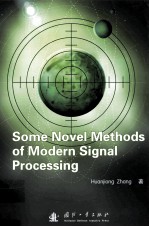

现代信号处理的若干新方法 英文版PDF电子书下载
- 电子书积分:10 积分如何计算积分?
- 作 者:张焕炯著
- 出 版 社:北京:国防工业出版社
- 出版年份:2014
- ISBN:9787118095913
- 页数:233 页
Chapter 1 Introduction 1
1.1 Summaries of modern signal processing 1
1.2 Characters analysis of the treating methods in modern signal processing 4
1.3 Characters and construction arrangements of this book of monograph 7
1.4 Summary of this chapter 10
Chapter 2 Some novel methods under the conditions of the structural interferences 11
2.1 Introduction 11
2.2 Analysis the influence of the receiving signals with structural interferences under the conditions between synchronous and asynchronous 24
2.2.1 The model of receiving signal 27
2.2.2 Analysis the structure of the baseband signal under the synchronous and asynchronous receiving conditions 29
2.2.3 Analysis of signal structure under the synchronous and asynchronous conditions of the carrier Phase 38
2.2.4 Analysis of the numerical simulation 43
2.2.5 Summary of this section 47
2.3 Analysis of the united detective methods base on the theory of the definite linear operator 47
2.3.1 System rodel 48
2.3.2 Related conclusions of the definite linear operator theory and the application in the united detection 50
2.3.3 The united detective method based on the theory of definite linear operator under the non-strict power control 52
2.3.4 Realization and correlated performances analysis 55
2.3.5 Two examples 59
2.3.6 Simulative analysis 65
2.3.7 the Summary in this section 68
2.4 The united detection based on solving the reverse of hermite matrix 68
2.4.1 The realization of the united detective method based on the theory of hermite matrix 69
2.4.2 Computing complexity analysis and simulation 72
2.4.3 The summary of this section 73
2.5 The novel decorrelating decision feedback united detective method 74
2.5.1 System model 74
2.5.2 Derivation of new decorrelating decision feedback method 76
2.5.3 Simulation analysis and case 78
2.5.4 The summary of this section 81
2.6 A novel united detective method under the asynchronous receiving condition 82
2.6.1 Introduction 82
2.6.2 Signal model 83
2.6.3 The derivation of this new united detective method 85
2.6.4 Properties analysis and simulation 88
2.6.5 The conclusion of this section 90
2.7 Blind united detective technologies 91
2.7.1 Introduction 91
2.7.2 The common model of the blind united detection 92
2.7.3 Some concrete blind united detective methods 93
2.7.4 The summary of this section 99
2.8 The diversity technology based on the fractional Fourier Transformation 101
2.8.1 Introduction 101
2.8.2 Some corresponding theoretical conclusions of fractional Fourier Transformation 102
2.8.3 The concrete analysis of the diversity realization based on the theory of FRFT 105
2.8.4 A cryptosystem scheme based on the theory of FRFT 107
2.8.5 The summary of this section 109
2.9 A modified method of delta modulation 109
2.9.1 Introduction 109
2.9.2 Delta modulation principle analysis 110
2.9.3 Derivation of the modified delta modulation method 112
2.9.4 Property analysis and an example 114
2.9.5 Conclusion of this section 115
2.10 Summary of this chapter 116
References 117
Chapter 3 Some novel methods of modern signal processing based on Information Theories 125
3.1 Introduction 126
3.2 Some conclusions in theories of information 129
3.2.1 Some basic conceptions 129
3.2.2 Some related properties of Shannon entropy and discrimination entropy 140
3.2.3 Some important principles and criteria 147
3.3 Signal detective models based on the information extreme value criteria 151
3.3.1 Signal detective model based on the maximum entropy criterion 152
3.3.2 Signal detective model based on the minimum discrimination entropy criterion 155
3.3.3 Signal detective model based on the minimum error entropy criterion 158
3.4 Analysis of some concrete examples 162
3.4.1 Application in the domain of spectra estimation 163
3.4.2 Application in the field of blind source separation 166
3.4.3 Analysis of the example based on the criterion of the minimum error entropy 173
3.5 Conception of information matched filtering 174
3.6 Summary of this chapter 179
References 180
Chapter 4 Some new methods about signal analysis based on the theories of abstract algebra 182
4.1 Introduction 182
4.2 The basic ideas and models of the signal classification,detection and recognition 185
4.3 New methods of signal classification,detection and recognition based on group theory 188
4.3.1 The related conceptions and conclusions of group theory 188
4.3.2 The concrete application in the domain of signal classification,detection and pattern recognition 194
4.3.3 Analysis of a concrete example 200
4.4 Some novel methods of signal classification,signal detection and pattern recognition based on the theories of ring and field 202
4.4.1 The definition and related properties of ring 202
4.4.2 Some related properties of field structure 205
4.4.3 the concrete application in the domains of signal classification,detection and recognition 207
4.4.4 An example analysis based on field theory 208
4.5 The current methods of signal classification,detection and pattern recognition based on the common algebra theories 210
4.6 A novel methods based on the theory of linear operator semigroup 212
4.6.1 The related theory of linear operator semigroup 212
4.6.2 The concrete processing based on theories of linear operator semigroup 215
4.7 Summary of this chapter 219
References 220
Chapter 5 Conclusions and Prospects 222
5.1 The conclusions of the whole book monograph 222
5.2 The expectation of the future researching 227
References 229
Postscript 230
Brief Introduction about this Book of Monograph 232
- 《卓有成效的管理者 中英文双语版》(美)彼得·德鲁克许是祥译;那国毅审校 2019
- 《基于地质雷达信号波的土壤重金属污染探测方法研究》赵贵章 2019
- 《大数据Hadoop 3.X分布式处理实战》吴章勇,杨强 2020
- 《AutoCAD 2018自学视频教程 标准版 中文版》CAD/CAM/CAE技术联盟 2019
- 《跟孩子一起看图学英文》张紫颖著 2019
- 《AutoCAD机械设计实例精解 2019中文版》北京兆迪科技有限公司编著 2019
- 《信号 修订版》铁道部通信信号公司研究设计院 1979
- 《复分析 英文版》(中国)李娜,马立新 2019
- 《张世祥小提琴启蒙教程 中英文双语版》张世祥编著 2017
- 《烧结法处理非常规含铁资源研究》王哲著 2018
- 《指向核心素养 北京十一学校名师教学设计 英语 七年级 上 配人教版》周志英总主编 2019
- 《北京生态环境保护》《北京环境保护丛书》编委会编著 2018
- 《指向核心素养 北京十一学校名师教学设计 英语 九年级 上 配人教版》周志英总主编 2019
- 《抗战三部曲 国防诗歌集》蒲风著 1937
- 《高等院校旅游专业系列教材 旅游企业岗位培训系列教材 新编北京导游英语》杨昆,鄢莉,谭明华 2019
- 《中国十大出版家》王震,贺越明著 1991
- 《近代民营出版机构的英语函授教育 以“商务、中华、开明”函授学校为个案 1915年-1946年版》丁伟 2017
- 《新工业时代 世界级工业家张毓强和他的“新石头记”》秦朔 2019
- 《智能制造高技能人才培养规划丛书 ABB工业机器人虚拟仿真教程》(中国)工控帮教研组 2019
- 《陶瓷工业节能减排技术丛书 陶瓷工业节能减排与污染综合治理》罗民华著 2017
